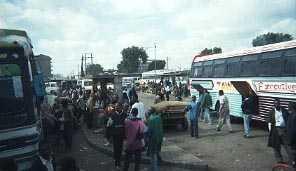
We had finished a safaria of the northern parks, next up was a safaria of the Selous Game Reserve in Southern Tanzania but first we had to get there. The starting point of southern safaris is the capital Dar-es-Saalam which is about an hour away by air from Arusha or many hours by road. Both to save some money plus to see some of the countryside we decide on a bus trip.
There are basically two types of buses, ordinary and luxury. If a choice is possible go for the luxury, it is not much more expensive, usually air-condtioned and much faster. The luxury bus from Arusha to Dar takes about 9 hours while the ordinary takes about 13 hours. During our bus trip we ran into the variety of traveller called The Ugly American. It is recommended to book your bus a day in advance if possible since they usually are full. The Ugly American showed up about 5 minutes before the bus left then proceeded to complain to every representive of the bus company about everything. He began to tell every local who would listen what was wrong with their country. This is the type of person who gives Americans a bad name aboard. When he complained to the bus driver that if he was not given a seat next to his (dutiful) wife then they can just left him off. The bus driver called him on it, pulled the bus off to the side of the road and opened the door to let him off. He shut up pretty quickly then and just sat and muttered. Eventually several people changed seats so he could sit next to his wife. They probably did it just so they would not have to listen to him criticize their country.
The roads are good between Arusha and Dar and you get a good view of Mt. Kilimanjaro as the bus nears Moshi, the buses only stop. Moshi is generally the starting point of Kilimanjaro treks. After about nine hours we arrived in Dar-es-saalam.
|
|
Dar has a population of about 1.5 million, its the capital and a port city. There's not much to see and most people come here to either catch a boat to Zanzibar or to start a southern safaria. One day to catch the few sites like the National Museum is plenty of time. Even though its a large city in a very poor country we saw few beggers. I swear I've seen more pan-handlers in large cities in America or Europe than I saw in Tanzania. There are plenty of street sellers and bargaining is the norm, an activity I throughly enough.
The parks of the south are rarely visited so there is less infrastructure and its more expensive than the north but you generally don't have to worry about traffic jams. Generally 3 parks are considered part of the southern route; Selous, Ruaha, and Mikumi. We decided to only visit Selous for reasons of time (it can take about 9 days to visit the southern parks), money (its expensive), and we assumed we be safaried out. We were wrong on that account. Mikumi can be visited from Dar using a good paved road and is often crowded on weekends. The other two parks are accessed using very bad roads. Selous is only 250 km from Dar but it takes about 7 hours by road to reach it. The parks can be visited by plane, its more expensive but we splurred.
Return to Top
Selous is not classified as a National Park but as a Game Reserve. It follows different rules for example there are a limited number of trophy hunting allowed.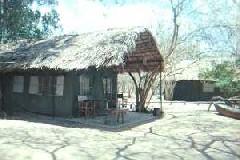 There is only one primitive camp site and five luxury tented sites, no lodges. The tents have concrete floors, high enough to stand up, beds, attached bathrooms and lights. That's my idea of camping. We stayed at the Rufiji River Camp whcih overlooks the river from atop of a high enbankment. Keep you tent zipped up, the monkeys have being known to steal.
There is only one primitive camp site and five luxury tented sites, no lodges. The tents have concrete floors, high enough to stand up, beds, attached bathrooms and lights. That's my idea of camping. We stayed at the Rufiji River Camp whcih overlooks the river from atop of a high enbankment. Keep you tent zipped up, the monkeys have being known to steal.
We arrived in Selous on the flight from Dar during mid-afternoon, the plane was a 6-seater Piper and it was a very bumpy flight. I do not recommend a meal of deep-fried chicken before a mid-afternoon flight in a small plane. I generally eat healthy with my only fast food weakness being the occasional meal of deep-fried chicken so for lunch we ate at The Chick King. With 5 passengers and the pilot I was sitting in the co-pilot seat and at about the half-way point in the flight all I could think about was what would happen if I spewed all over the instrument panel. Concentrating on that pit of fried chicken sitting in my stomach I could not even enjoy the site of giraffe grazing at the edge of the dirt runway.
The Rufiji River has the largest water catchment area in East Africa and is one of the few places in Tanzania were river safaris occur. Stately borassus palm trees line the banks of the wide brown river, apparently the sap of these trees is used to brew a potent palm wine.Also on the river safari were two American women, recent university graduates who were doing some travelling around Tanzania before starting some development work. We had meant these women several days previous on the bus trip from Arusha to Dar-es-Salaam. They had finished a Kilimanjaro hike, apparently because of altitude sickness only about 10% of the people actually make it to the top of Uhuru Peak. I expected few travellers but I certainly did not expect to meet up with people I've already meant, especially in a park, which only receives about 3500 visitors a year.
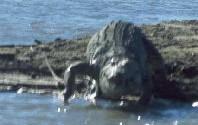
The river abounds with hippos and crocodiles and is a bird watchers paradise. I'm not much of a bird watcher myself but one of the American women was and our guide pointed out plenty of birds including fish eagles, Goliath herons, Egyptian geese and the brightly coloured carmine bee-eaters. The carmine bee-eaters catch bees with its beak in mid-air then scraps the stinger off against tree bark before eating the bee. Our guide told us that the hippopotamus, although herbivorous, are probably responsible for more deaths than any other animal in East Africa. They are very territorial and despite their huge size are fast. Don't get between a hippo and the water, it will run you over and they also can overturn small boats that get too close. Herds of hippos wallowed in shallow pools but retreated to deeper water before we got very close with our boat. If the hippos don't get you than there are the crocodiles basking on the shore with open mouths to dispel the heat quickly take to the water as the boat approaches, one crocodile rushed into the water very close to us as I snapped a quick picture. The two-hour river safari concluded as we returned to camp as the sun was setting and hippos were leaving the water to begin their nights foraging and velvet monkeys were foraging near the camp.
The Selous Game Reserve is approximately 54,000 km2 of largely untouched wilderness probably the largest protected wilderness in Africa. Although a large park only the northeast corner is developed for tourism, the area south of the Rufiji River is the domain of the sports hunter. The Selous is ecologically different from the parks of northern Tanzania. It is a hot, humid park most of it below 600 metres in elevation and vast areas of the park are covered in woodland. The northern parks are drier and cooler and above 600 metres in elevation with mostly grassland dominating the vegetation. The area in the northeast section of the park is part of the floodplain of the Rufiji River.
Return to Top
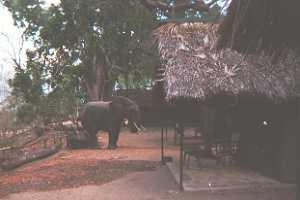
Our first full day started out with being awoken very early by an elephant forging right outside the tent. I had to get a picture of this but the vegatation obstructed my shot. Soon the elephant walked right in front of the tent and continued pass the tent. It stopped about two tents down and started to forge again. I left the tent to get a good picture but as soon as I snapped the picture the elephant turned toward me and ran, ears flapping, trunk raised and bellowing. I was charged by a moose once but this was much larger. On the assumtion that the elephant saw the tent as a solid object I dashed back into the tent. Fortunately the elephant ran pass the tent, stopped, and went back to eating. I saw someone else taking a picture, the elephant charged him also, he probably set a new world record.
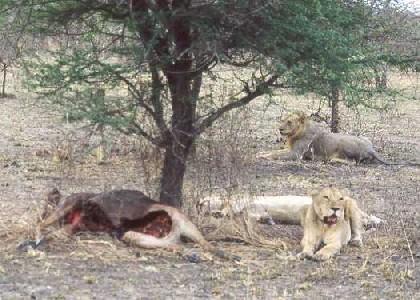
That was exciting and before breakfast too. Today we had a full day vehicle safaria booked. We had an excellent guide and only saw one other vehicle all day. That vehicle was a researcher from Sweden tracking lions. You definitely need a good guide when you visit the Selous. In the northern parks you can often spot animals by noticing other vehicles, this is especially true in Ngorongoro, in the south you are depending on your guide to find the animals. Also in the south the animals are not as habituated to vehicles so most of the animals are wary of vehicles and will run if you get too close. Except the lions and we saw plenty of lions. Unfortunately we just missed a kill but located a fresh kill by noticing vultures. Also saw a flock of vultures consume a baby antelope. Heather like the zebras, Vicki liked the girafee but I prefer the violence. Unlike other animals in the Selous the lions did not appear to be cautious of us, in fact they just stared at us. The male lion even lick his face while staring at us, I was reminded of a Far Side cartoon "No fur, no hoofs, no antlers, just soft and pink."
The course of the safari took us along the floodplain area of the Rufiji, which is fairly open and contains plenty of animals. The dirt track skirt the edge of a string of lakes and bird-filled swamps created by the river's meandering. Not far from the floodplain is lightly wooded terminalia country, which also contains massive baobabs along with giant termite mounds, which often have tamarind or ebony trees growing on them. Local craftsmen in Tanzania make makonde carvings use ebony; you can buy cheap and good carvings at local markets in Arusha and Dar es Salaam or spend more at tourist's shops along the safari routes. This late in the dry season most of the grass has been burnt off and the woodlands have lost most of their leaves, which makes game viewing much easier.
Nothing compares to Ngorongoro Crater for masses of game or ease of game viewing but the Selous has an impressive amount of game and is wonderfully scenic plus the lack of other vehicles certainly gives you the feeling that you have the park all to yourself. Our full-day safaria of the Selous was probably the most enjoyable of all the safaris.
Return to Top
Our third and last day in the Selous was started again by being awakened by the elephant. After breakfast our safari walk was delayed because we could not get into our tent to get our stuff because the elephant was in front of the tent. The owner of the camp lured the elephant away by taking a picture of him.
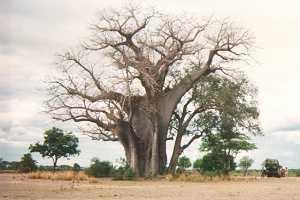
Since Selous is not a national park, it is one of the few places were walking safaris can be conducted and is consisted a Selous speciality. Several of the northern parks have guided mountain treks, Mt. Kilimanjaro in the park of the same name and Mt. Meru in Arusha National Park. Although we did not see much wildlife on a walking safari, our armed guide pointed out small details we can missed while sitting in a vehicle like signs of animals like hyena droppings and elephant footprints. Although the armed guide was one reason I was not worried about running into any carnivores, the main reason I was not afraid was because I figured I did not have to run faster than the carnivore just faster than the other people on the safari. I might have already had a close encounter with a wild cat but lions do eat bigger game than rodents and birds. While on the walking safari we did see some wildlife; a giraffe, some warthogs, a bushbuck, and a black and white colobus monkey. I had seen plenty of giraffe while in Tanzania but seeing one from ground level makes you really appreciate their size, although not as heavy as elephants at over 5 metres they are impressive creatures. Many people think warthogs are ugly but with their Mohawk style spiked reddish hair between their ears and the way they run with their tail sticking straight up I found them cute. Our walk also took us to a mbuga, which is a large depression of soil that floods during the rainy season. As they dry out various grasses spring up and animals not only feed on the grass but also wallow in the water. Elephants and buffalo churn deeply in the muck and as the dry season advances their footprints become frozen in the clay, which turns cement-hard making it uncomfortable to negotiate on foot. The walk took us to the boundary of the reserve where a camp vehicle was waiting with cold water to take us back to the camp for lunch and our return flight. It was easy to see where the reserve ended; cleared farmland marked the park boundary.
Return to Top
We had braved the wilds of Africa, being charged by an elephant, had a lion stare back at us but the idea of getting back on a light aircraft terrify us. As the plane flew overhead to make its landing at the nearby airstrip we noticed that it was a larger aircraft, a Cessana, it should be an easier flight. The Rufiji River Camp staff took us to the airstrip for our flight to our next destination, Zanzibar. In my e-mail correspondence with Takims I mentioned we were going to Zanzibar after Selous so they made arrangements for the flight to take us to Zanzibar, at no extra cost.

 There is only one primitive camp site and five luxury tented sites, no lodges. The tents have concrete floors, high enough to stand up, beds, attached bathrooms and lights. That's my idea of camping. We stayed at the Rufiji River Camp whcih overlooks the river from atop of a high enbankment. Keep you tent zipped up, the monkeys have being known to steal.
There is only one primitive camp site and five luxury tented sites, no lodges. The tents have concrete floors, high enough to stand up, beds, attached bathrooms and lights. That's my idea of camping. We stayed at the Rufiji River Camp whcih overlooks the river from atop of a high enbankment. Keep you tent zipped up, the monkeys have being known to steal.


